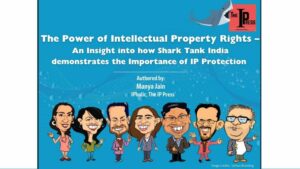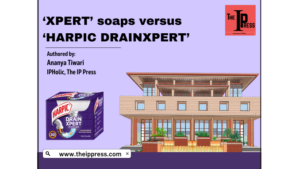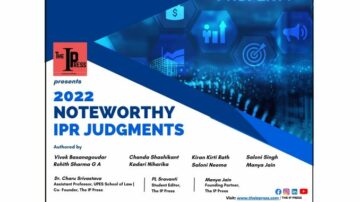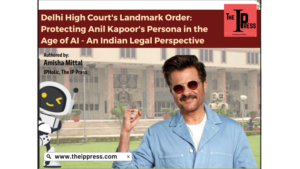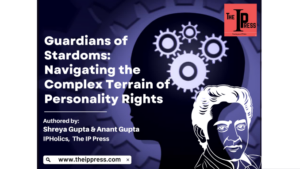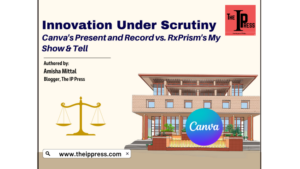

Let’s delve into a journey of copyright on Religious Scriptures, where the sacred Religious books encounter Intellectual Property rights giving rise to discussions on ownership and usage of sacred knowledge.
Copyright being one of the most important Intellectual property rights acts as a shield to the creators of original literary, dramatic, artistic, and musical works, cinematograph films, and sound recordings. This comprises a wide range of privileges such as the right to reproduce, communicate, adapt, and translate the work under copyright protection. So it can be said that Copyright acts as a custodian procuring the rights of authors of the copyrighted work.
The Indian Copyright Act, 1957 and the Copyright rules form the foundation of Copyright protection in India. It is important to note that mere concepts or ideas cannot be copyrighted but the original expression of such ideas or concepts is subject to copyright as we can see in the R.G. Anand case (AIR 1978 SC 1613) where the court granted copyright protection only to the original expression of the ideas or concepts and not to the ideas itself. This copyright protection does not restrict rights only to the creator; it can also be claimed by those who acquire the copyrights from the owner or also by a person acting on behalf of the owner of the copyrighted work.
The famous religious texts in India such as the Mahabharata, Quran, and Bible hold authority as a source of wisdom and divine guidance. The sacred Religious texts books deal with basic life principles and teachings. Millions of people embrace these religious scriptures in their daily lives.
Here arises a question: Copyright protection can be granted to Religious Scriptures?
NO, Religious Scripts are not subject to copyright. Religious scriptures exist in the public domain so they are not subject to copyright protection. This denotes that ancient religious texts such as Mahabharata, Bhagavad-Gita, Quran, Old Testament, New Testament, or conventional renditions of the Bible are exempt from copyright protection. It is crucial to note that modern translations and interpretations of these religious texts are eligible for copyright protection as original distinctive works by the creator.
The New International Version Bible (NIV) released in 1978 is safeguarded by Copyright © 1973, 1978, 1984, 2011 by Biblica, Inc. To use this NIV text, permission, or compliance with the copyright holder is required. Although Religious texts like the Ramayana and Mahabharata lack copyright protection, transformative works like Ramanand Sagar’s television series Ramayana or B R Chopra’s Mahabharata are subject to copyright protection.
In a recent decision by the Delhi High Court in the case filed by the Bhaktivedanta Book Trust against Bhagavatam (CS(COMM) 657/2023 and I.A. 18425/2023-18431/2023) seeking a permanent injunction against copyright infringement, damages, and other remedies. Legal action was taken against some John Doe websites and mobile applications accused of copying the Plaintiff’s copyrighted works without getting permission from the owner.
In the present case, the plaintiff was granted copyright protection for translated religious texts called “Shlokas”. The Delhi High Court observed that the religious scriptures cannot be protected by copyright but copyright protection can be provided to the adaptations of scriptures, including explanations, summaries, meanings, interpretations, or any transformative works such as audio-visual or dramatic works. In the present case, the Defendants created works that were beyond mere reproduction of religious scriptures, it included the summary, introduction, preface, cover, etc., of the Plaintiff’s copyrighted works. The court ordered to take down the infringing websites, and mobile applications and also prohibited the Defendants from reproducing, printing, communicating, etc., any part of the Plaintiff’s works.
Scenario beyond Indian borders
Looking into the American scenario the connection between Copyright Law and religious scriptures in the United States is complex and sometimes unclear. The Copyright protection which was designed to safeguard the original works for a specific period creates challenges when it is applied to religious texts. Many of these religious texts existed long before the origin of modern copyright laws and possess significant cultural and spiritual importance.
Similar to India the US Copyright law also does not provide copyright protection to works that have fallen into the public domain like religious scriptures. However, the work that is in the public domain involves some modification, translation, musical arrangement, dramatization, fictionalization, motion picture version, sound recording, art reproduction, etc. are considered as “derivative work” as per section 101 of the US Copyright Act of 1976 and can be subject to Copyright protection.
In a recent case between JBrick, LLC v. Chazak Kinder, Inc. et al, 1-21-cv-02883 (EDNY Sep. 21, 2023), where the plaintiff created a Lego-brick interpretation of the “Second Holy Temple” based on independent research on various written scripts and consultation with rabbis. The plaintiff has registered copyright for the Second Holy Temple Product including its image. The defendants produced a similar product and argued that since the information about the Second Holy Temple is publicly available, the plaintiff’s copyrighted works lack originality. The Eastern District of New York’s District Court held that the plaintiff’s work was subject to copyright protection because it was sufficiently creative. The Court determined that any reasonable juror would agree that the Plaintiff’s Second Holy Temple Product, acknowledged by both parties as derived from a translation involving research, analysis, and interpretation of written Jewish religious texts to create a 3D sculpture of a structure destroyed in 70 C.E., demonstrates enough creativity to qualify for copyright protection.
Considering the Copyright issues such as the ownership and accessibility of these Religious Scripts, it reflects the collision of ancient wisdom and modern legal complexities. Comparing the situation in India and the United States, reveals copyright laws are facing difficulties with these challenges, attempting to protect the derivative and adaptations of these works while at the same time trying to recognize the spiritual values of religious scriptures. All these complexities indicate a tire need to address a balance between the protection of Religious texts and the ever-changing Copyright legal implications.
- SEO Powered Content & PR Distribution. Get Amplified Today.
- PlatoData.Network Vertical Generative Ai. Empower Yourself. Access Here.
- PlatoAiStream. Web3 Intelligence. Knowledge Amplified. Access Here.
- PlatoESG. Carbon, CleanTech, Energy, Environment, Solar, Waste Management. Access Here.
- PlatoHealth. Biotech and Clinical Trials Intelligence. Access Here.
- Source: https://www.theippress.com/2024/01/25/exploring-the-copyright-complexities-of-religious-scriptures-a-blend-of-ancient-wisdom-and-modern-legality/
- :has
- :is
- :not
- :where
- 11
- 1973
- 2011
- 2023
- 3d
- 70
- a
- About
- accessibility
- accused
- acknowledged
- acquire
- Act
- acting
- Action
- acts
- adapt
- Adaptations
- address
- against
- AIR
- AL
- All
- also
- Although
- American
- analysis
- Ancient
- and
- any
- applications
- applied
- ARE
- argued
- arrangement
- Art
- artistic
- AS
- At
- attempting
- authority
- authors
- available
- b
- Balance
- based
- basic
- BE
- because
- before
- behalf
- being
- between
- Beyond
- Blend
- Blog
- book
- Books
- both
- both parties
- but
- by
- called
- CAN
- cannot
- case
- challenges
- claimed
- collision
- comm
- communicate
- communicating
- comparing
- complex
- complexities
- compliance
- comprises
- concepts
- connection
- considered
- consultation
- conventional
- copying
- copyright
- copyright infringement
- Copyrights
- Court
- cover
- create
- created
- creates
- Creative
- creativity
- creator
- creators
- crucial
- cultural
- custodian
- daily
- deal
- decision
- defendants
- Delhi
- delve
- demonstrates
- denotes
- derivative
- Derived
- designed
- destroyed
- determined
- difficulties
- discussions
- distinctive
- district
- district court
- DOE
- does
- domain
- down
- dramatic
- e
- E&T
- eastern
- eligible
- embrace
- encounter
- enough
- etc
- ever-changing
- exempt
- exist
- Exploring
- expression
- facing
- Fallen
- famous
- filed
- films
- For
- form
- Foundation
- from
- getting
- Giving
- granted
- guidance
- Have
- Held
- High
- hold
- holder
- However
- HTTPS
- i
- ideas
- image
- implications
- importance
- important
- in
- Inc.
- included
- Including
- independent
- india
- Indian
- indicate
- information
- infringement
- intellectual
- intellectual property
- International
- interpretation
- into
- Introduction
- involves
- involving
- IP
- issues
- IT
- ITS
- itself
- jewish
- John
- JOHN DOE
- journey
- knowledge
- Lack
- Law
- Laws
- Legal
- Legal Action
- Life
- like
- Lives
- LLC
- Long
- many
- meanings
- mere
- millions
- Mobile
- Mobile Applications
- Modern
- most
- motion
- musical
- Need
- New
- New York’s
- note
- observed
- of
- Old
- on
- ONE
- only
- or
- Origin
- original
- originality
- Other
- owner
- ownership
- part
- parties
- People
- per
- period
- permanent
- permission
- person
- picture
- plato
- Plato Data Intelligence
- PlatoData
- possess
- posters
- present
- press
- principles
- printing
- privileges
- Produced
- Product
- prohibited
- property
- Property Rights
- protect
- protected
- protection
- provide
- provided
- public
- publicly
- qualify
- question
- QURAN
- R
- range
- reasonable
- recent
- recognize
- recording
- reflects
- registered
- released
- reproduction
- required
- research
- restrict
- Reveals
- right
- rights
- Rise
- rules
- safeguarded
- Said
- same
- SC
- scenario
- scripts
- Second
- Section
- see
- seeking
- Series
- Shield
- significant
- similar
- since
- situation
- So
- some
- sometimes
- Sound
- Source
- specific
- States
- structure
- subject
- such
- SUMMARY
- Take
- taken
- television
- testament
- text
- that
- The
- the information
- their
- These
- they
- this
- those
- time
- tire
- to
- transformative
- translate
- Translation
- Translations
- Trust
- trying
- unclear
- under
- United
- United States
- us
- Usage
- use
- Values
- various
- version
- was
- we
- websites
- were
- when
- which
- while
- WHO
- wide
- Wide range
- wisdom
- with
- without
- Work
- works
- would
- written
- zephyrnet


